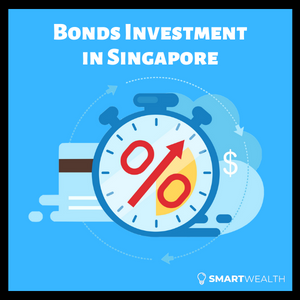More people are seeing the wisdom of investing early to grow their wealth.
As one of the more common types of financial instruments in the market, bonds are something that everyone should definitely seek to understand before deciding which tool to invest in.
In this article, you’ll get to understand how bonds work and what are the different types of bonds out there in the market.
So, read on!
What Are Bonds (And How Do They Work)?
A bond represents a loan from the investor to the entity who issued the bond. Bonds are typically issued by governments or companies to raise funds. When an investor buys a bond, they are lending their money to the issuer for the stipulated period of time.
There are two main ways investors can earn from investing in bonds. The most common way they earn is through interest payments, which are known as coupons. Bonds are sometimes called fixed income securities as they traditionally pay out regular fixed interest payments. However, there are now bonds that offer variable interest payments as well. These bonds pay less when the company or market is doing poorly and more when they are doing well. The principal is also returned to the investor at the end when the bond matures.
The second way investors typically earn from bonds is by capital gains. In the case of zero coupon bonds, investors pay a discounted price for the bond, which eventually matures at par value. They can then redeem the bond at par value, thus gaining the capital difference between par value and the discounted price.
SIDE NOTE When was the last time you conducted thorough financial planning or reviewed your finances? In this day and age in Singapore, doing so will absolutely improve the quality of life for you and your loved ones. Here are 5 reasons why financial planning is so important.
Bonds Come in Different Shapes and Sizes
As mentioned above, there are different types of bonds and the type of interest or capital gained from investing in each type of bond may differ.
Apart from traditional bonds, the three main types of bonds to take note of are zero coupon bonds, convertible bonds and perpetual bonds.
We have touched on zero coupon bonds above.
Convertible bonds are bonds that can be exchanged for stocks at a later date. They may offer a slightly lower interest rate compared to traditional bonds, but give investors the potential upside of converting the bonds for stocks if the stocks rise in value.
Perpetual bonds are simply bonds with no maturity rate, paying coupons for as long as the investor holds on to them.
3 Main Factors That Affect the Pricing & Yields of Bonds
1) Bond Rating
Bond ratings represent the credibility of government or corporate bonds. These ratings are typically published by credit rating agencies who evaluate the bond issuer’s creditworthiness and financial capability. An entity which is deemed to be more financially stable and able to pay the bond’s principal and interest as promised is given a higher rating.
The main credit rating agencies are S&P, Moody’s, and Fitch. Each of them use different rating systems to evaluate if a bond is investment grade or non-investment grade and speculative.
Investment grade bonds are considered to be safer but may provide lower yields compared to risky non-investment grade bonds. They may also tend to be more expensive. Across the board, AAA investment grade bonds are the most trustworthy and typically pricier than lower grade bonds as there is low risk of default.
2) Market Interest Rates
Bond prices typically have an inverse correlation with market interest rates. The higher the market’s interest rates, the lower the price of bonds. This is because higher market interest rates or yield represent the opportunity to earn more interest elsewhere, in newer bonds or other financial instruments, instead of holding onto the old bonds. This leads to a decrease in the price of existing bonds. Thus, in most cases, the higher the market interest rate, the lower the price of existing bonds. The reverse is also true.
3) Maturities
The longer the period to maturity, the lower the price of a bond. This is because there is greater risk of changes and defaults in long-term debt such as bonds. Thus, bonds with long maturities offer discounted pricing to attract investors.
3 Broad Types of Bonds in Singapore
There are three main categories of bonds in Singapore. They are: government bonds, corporate bonds, and unit trusts/ETFs.
1) Government Bonds
One of the government bonds that retail investors can opt for is the Singapore Government Securities (SGS) bonds. Generally, they pay fixed interest rates and repay the initial principal at maturity or redemption. Their maturity periods can range from two to 30 years. SGS bonds are fully backed by the Singapore government and are considered to be one of the safest financial instruments available in the market, with the government’s strong AAA credit rating. In fact, the Singapore government does not need the extra funding or use it for its expenditure. Instead, the purpose of government bonds are largely to provide safe, long-term investment options for people in Singapore.
There are three categories of SGS bonds, namely SGS (Market Development), SGS (Infrastructure) and Green SGS (Infrastructure), which have different objectives.
Another type of government bond is the Singapore Savings Bonds (SSB). The returns are similarly guaranteed by the Singapore government, with an AAA credit rating. The maturity period is 10 years, although investors can choose to redeem the bonds at an earlier date.
Additionally, there are indirectly government-linked bonds, such as Temasek bonds. The Temasek bonds have received the top AAA credit ratings according to S&P and Moody’s. The tenor is set at 5 years, and the coupon rates are fixed at 2.7% per year, paid out every 6 months.
2) Corporate Bonds
If you are keen to diversify your portfolio away from government bonds, or are willing to take on more risk for higher rewards, you can look into corporate bonds as well. Corporate bonds are issued by private or public companies in order to raise funds. The riskier the profile of the company, the higher the yield tends to be, in order to attract more investors.
3) Bond Unit Trusts and ETFs
Bond unit trusts and exchange-traded funds (ETFs) are a type of financial instrument that can include a portfolio or bonds. For instance, they could include government bonds and/or corporate bonds.
Although they are often categorised together, unit trusts and ETFs are slightly different. A unit trust, also known as a mutual fund, is an instrument that is actively managed by fund managers. The fund manager uses the pool of money contributed by retail investors to selectively invest in individual securities such as bonds and stocks. Unit trusts can typically be bought through banks or agents.
On the other hand, ETFs are investment tools that track certain indices. For example, the S&P500 is the most reputed index, which comprises the top 500 companies in the world according to S&P. The S&P500 ETF, SPY, is traded on stock exchanges and follows the aggregated stock performance of these 500 companies according to the index. There are other indices which are more focused on a specific industry, such as technology or energy. ETFs can track a mixture of different asset classes, such as stocks or bonds.
6 Pros and Cons of Bonds as Investments
Pros
1) Relatively safe with lower volatility
The main reason people opt for bonds is because of their high stability and low risk. Unless the company defaults or goes bankrupt, they are liable to repay the initial principal fully, as well as the promised interest. This is very different from stocks and equity, where there is absolutely no guarantee. In theory, stockholders can lose all their capital if the value of their stocks plunge. Thus, as long as investors choose companies that have financial stability and are not likely to default, they are most likely to gain from the investment.
DID YOU KNOW? According to a survey conducted by MoneySense, about 3 out of 10 Singapore residents aged 30 to 59 had not started planning for their future financial needs. This isn't surprising because personal finance can seem complicated and daunting. But really, there are only a few things that you should focus on. Learn how to significantly improve your personal finances with the 7-step "wedding cake" strategy today.
2) Receive regular coupon payments
Another rationale for choosing bonds could be the frequency of interest payments. Unlike other forms of investment, bonds pay out regular coupons every few months. This means that the bondholder is able to stay invested while reaping the benefits of the interest payments right away. They can then utilise these interest payments for further investment in other instruments, or for their expenses. The fact that they do not have to wait till maturity to start gaining from this investment attracts many retail investors to opt for bonds as one of the instruments in their portfolio.
3) Have some liquidity
Most bonds can be redeemed early at no cost. For example, the Singapore Savings Bonds can be redeemed in any month from the time of purchase with no penalty. This gives retail investors the option of getting their funds back in cases of emergency, instead of having it locked in.
4) Great for diversification
Bonds can be a great way to diversify your portfolio. People who are already invested in stocks and equities or other riskier financial instruments may find it beneficial to portion a sum of their funds and allocate it in bonds, which carry low risk.
Cons
5) Low risk doesn’t mean no risk
Of course, any investment tool carries some amount of risk. The moment you release your funds out to a third party, there is always the risk of you not getting your money back. Even if you invest in bonds with high credit ratings, there is always the low probability that the bond defaults. This is because bonds are long-term investments. With such a long time horizon, it is difficult to predict the future. There is always the chance that credit ratings may drop in the future if the company or relevant markets decline significantly in performance and fall into bad debt.
6) Lower yields compared to other asset classes like equities
The trade-off to facing lower risk is that bonds typically offer lower yields as well. This is only fair, as bond investors take on less risk when buying a bond and thus do not need to be compensated for it.
How to Buy and Sell Bonds in Singapore
Bonds can be bought easily through several avenues. The way you can buy and sell a bond differs depending on the type of bond bought.
To buy government bonds, one can buy them through internet banking and ATMs. The release and auction dates of the bonds can be found in the issuance calendars.
The SGS bonds can be sold in the secondary market on the SGX. Not all government bonds can be sold, however. SSBs can only be redeemed through the local banks or via SRS at a small transaction fee, and are not resellable.
To buy and sell corporate bonds, one can either buy them when they are first issued via the banks and ATMs, or go through secondary market transactions on the SGX.
Last but not least, unit trusts and ETFs can typically be bought through online brokerages and platforms, banks, and financial advisors.
Investing in Bonds vs Equities (Stocks)
As explained above, bonds can be a great way for retail investors to diversify their portfolios. By allocating at least some of their funds into bonds, investors safeguard a portion of their wealth while gaining just enough interest to offset inflation. This gives them more assurance to invest the rest of their extra funds in riskier tools to maximise gains. By having some funds in bonds also allow the investor to have sufficient “ammunition” to fire, especially when equity markets are down.
The exact asset allocation will however depend on each individual. For instance, investors may choose to invest 80% of their funds into bonds and only 20% into stocks and equities if they are more conservative, or 50% into each if they want a balanced portfolio. Meanwhile, those who have a larger risk appetite or greater pool of extra funds may opt for a 20% allocation into bonds and direct 80% of their funds into equities.
Bond Alternatives: What are the Other Options?
1) Fixed Deposits
Fixed deposits are a financial instrument that requires investors to deposit an agreed sum of money. In return, they earn an interest rate that is relatively higher than that of regular savings accounts. While investors are allowed to withdraw their fixed deposits anytime they wish, this often comes with possibility of getting less or no interest payment.
2) Cash Management Accounts
Cash management accounts (CMAs) combine savings and investment services under one product. They are able to offer higher projected interest rates than traditional banks. StashAway Simple and Syfe Cash+ are examples of cash management accounts. Although such accounts invest mainly in bonds, there is still a possiblility of going into the red.
3) CPF Top-Ups
Did you know that you can earn a fair amount of interest from CPF as well? Funds in the Ordinary Account (OA) earn a base interest of 2.5% per annum, while the interest rate for the Special Account (SA), Medisave Account (MA) and Retirement Account (RA) is 4% per annum. In addition, the first $60,000 of all combined CPF monies also earn an extra 1% interest per year, if you are younger than 55 years old. If you are 55 years old and above, you will get an extra 2% on the first $30,000 of combined CPF funds and 1% on the next $30,000.
As such, topping up one’s CPF can be a great way to safeguard funds and earn attractive interest.
4) Endowment Savings Plans
Endowment plans usually offer higher interest rates than both bonds and fixed deposits. They require the investor to pay either a single lump sum premium, or staggered premiums over a longer period of time. They typically have long maturity periods of up to 30 years.
The main difference between endowment savings plans and fixed deposits is that these plans usually require the investor to hold till maturity. If these plans are surrendered early, there may be a loss of capital.
However, the perk for such plans is that the total potential returns could be higher than other alternatives.


